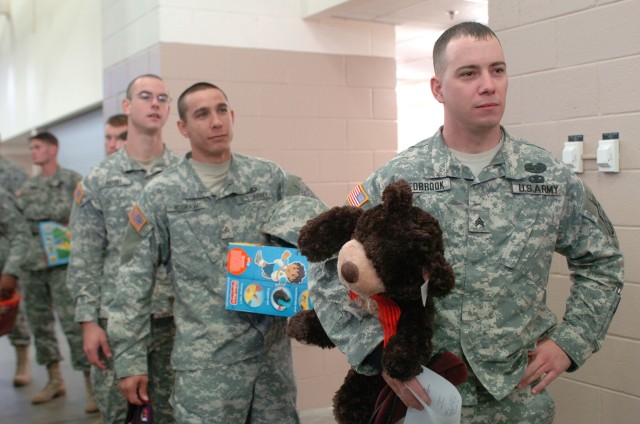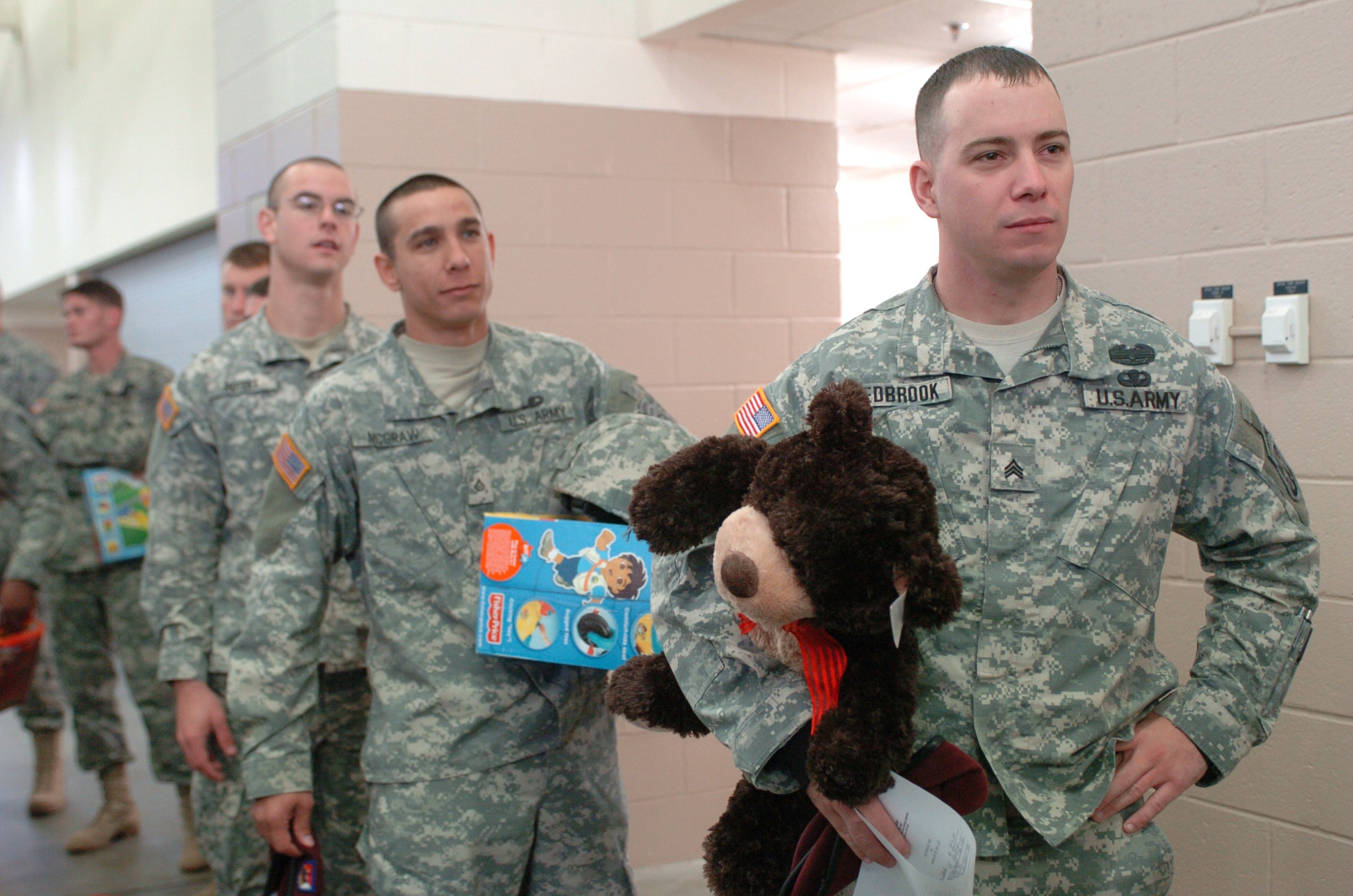
FORT BRAGG, N.C. - Dozens of parachute silhouettes raining down against the North Carolina sky are nothing out of the ordinary around Fort Bragg, but each December since 1998, airborne operations have taken on a different meaning to America's men and women in uniform with the Randy Oler Memorial Operation Toy Drop.
An annual opportunity for Fort Bragg's military community to help Families in need over the holidays, Operation Toy Drop combines the efforts of Army, Air Force and civilian service organizations in a truly unique event.
Operation Toy Drop is a week-long, philanthropic project where Fort Bragg's paratroopers (or visiting paratroopers from across the nation) individually contribute new, unwrapped toys to be distributed to local children's homes and social service agencies.
Despite the project's name, these toys are not "dropped" anywhere except into the arms of deserving children throughout Cumberland County and North Carolina. The drop is actually a daytime, non-tactical airborne operation supervised by foreign military jumpmasters - a rare treat for participating Soldiers who relish the opportunity to earn a foreign nation's "jump wings."
Masterminded by then-Staff Sgt. Randy Oler in 1998, Operation Toy Drop started as a relatively small-time success backed by some big-time coordination. Oler's dream of incorporating airborne operations, foreign military jumpmasters and local charities was a tall order, but Oler was never one to shy away from a challenge.
He approached his commanding general within the U.S. Army Civil Affairs and Psychological Operations Command with the idea and was given the green light to spearhead the project.
That December, after eight months of planning, USACAPOC's first Operation Toy Drop had been completed on a wing, a prayer and Oler's handshakes across several organizations. It was small, and very few toys had actually been raised - but it was a start, and from that point on Oler had a foundation to build on.
Over the following years, Operation Toy Drop expanded to include aircraft support from Pope Air Force Base's 43rd Airlift Wing, and welcomed the participation of Soldiers from Fort Bragg's XVIII Airborne Corps and 82nd Airborne Division.
These Soldiers' enthusiasm to participate in the budding holiday tradition greatly outweighed the number of jump slots available. With limited space on the planes, the project's organizers arranged to draw names of participating Soldiers at random to fill the slots. The name drawing has become one of the highlights of Operation Toy Drop. Hundreds of Soldiers crowd together for the chance to hear their ticket number called, no matter how long the wait.
Each iteration of Operation Toy Drop has brought in more toys for children in need. Even as USACAPOC Soldiers mobilized with the rest of U.S. Army in support of the Global War on Terrorism, those who remained stateside continued the tradition.
In 2001, each child who lost a Family member in the Sept. 11 attacks received a toy during that year's Operation Toy Drop.
As the war broke out, Oler remained at the helm of the operation. By April 2004, he was been promoted to sergeant first class and was finishing up an assignment at the U.S. Army John F. Kennedy Special Warfare Center and School.
Even as the USACAPOC commanding general was fighting Oler's relocation orders, which would take him away from Fort Bragg, Oler was starting to get the ball rolling for the 2004 Operation Toy Drop, which was less than eight months away.
Oler had warned his colleagues that he might not be around for what would have been his seventh year running Operation Toy Drop.
Sadly, he was right, but not due to any relocation orders. On April 20, 2004, Oler suffered a heart attack while performing jumpmaster duties aboard a C-130 aircraft. At age 43, Oler was pronounced dead at Womack Army Medical Center.
The Tennessee native joined the Army in 1979 as an infantryman, spending time in Ranger and Special Forces battalions throughout his career. He deployed in support of Operations Desert Storm, Provide Comfort and Joint Endeavor.
In 1995, he joined USACAPOC to become a civil affairs specialist.
Oler's humanitarian spirit built Operation Toy Drop from the ground up, and it's only appropriate that the December following his death, his dream-turned-reality was dubbed the Randy Oler Memorial Operation Toy Drop by those who had worked so closely with him over the years.
The void left by Oler's death was a difficult one to fill. Oler ran the operation from memory for six years. With no written notes to work from, key players scrambled to make the connections that Oler had worked from his head over the previous years.
To date, volunteers with Operation Toy Drop have collected and distributed more than 35,000 toys. Everything from bikes, dolls and video game systems have gone to local Families and children in need.
During the event's 10-year anniversary in 2007, more than 3,000 participants brought in nearly $55,000 worth of toys.
USACAPOC, a subordinate of the Army Reserve Command, has had control over Operation Toy Drop since Oler, a USACAPOC Soldier, initiated the event in 1998. Oler's passion for helping those in need is echoed again and again among USACAPOC's nearly 10,000 Army Reservists, whose civilian experiences play important roles in their units' missions overseas.
By conducting civil-military projects and humanitarian assistance efforts, USACAPOC Soldiers are making contributions to global peace and stability across the world. Located here, USACAPOC is headquarters to the 69th Army Reserve Civil Affairs and Psychological Operations units across the nation.
Civil affairs and PSYOP Soldiers account for only 5 percent of the U.S. Army Reserve force, but comprise 20 percent of Army Reserve deployments.

Social Sharing